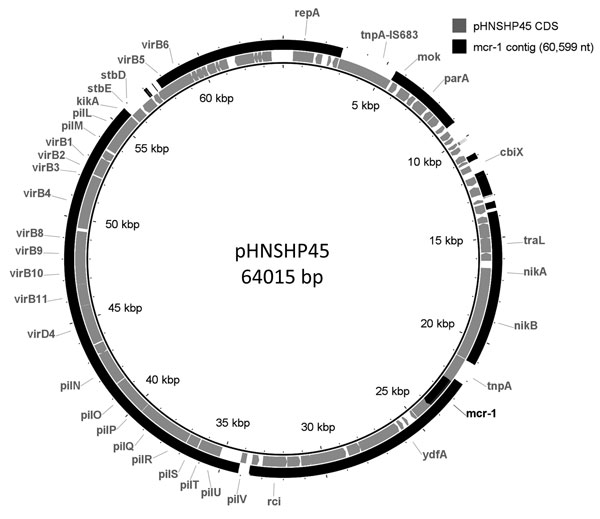Volume 22, Number 9—September 2016
Letter
mcr-1–Positive Colistin-Resistant Escherichia coli in Traveler Returning to Canada from China
Figure

Figure. The mcr-1–containing contig from Escherichia coli isolated from a traveler returning to Canada from China compared to pHNSHP45 plasmid. BRIG (6) was used to generate a visual representation of the 60,599-nt contig assembled from the sequencing of the mcr-1–positive isolate to pHNSHP45 (2). Coding regions are represented in the inner ring; the mcr-1–containing contig is represented in the outer ring. The mcr-1 gene is indicated in a black segment in the inner ring.
References
- The European Committee on Antimicrobial Susceptibility Testing. Breakpoint tables for interpretation of MICs and zone diameters. Version 6.0. The Committee; 2016. http://aurosan.de/wp-content/uploads/2015/05/v_6.0_Breakpoint_table.pdf
- Liu YY, Wang Y, Walsh TR, Yi LX, Zhang R, Spencer J, Emergence of plasmid-mediated colistin resistance mechanism MCR-1 in animals and human beings in China: A microbiological and molecular biological study. Lancet Infect Dis. 2016;16:161–8.PubMedGoogle Scholar
- Ingle D, Valcanis M, Kuzevski A, Tauschek M, Inouye M, Stinear T, In silico serotyping of E. coli from short read data identifies limited novel O-loci but extensive diversity of O:H serotype combinations within and between pathogenic lineages. Microbial Genomics. 2016.
- Carattoli A, Zankari E, García-Fernández A, Voldby Larsen M, Lund O, Villa L, In silico detection and typing of plasmids using PlasmidFinder and plasmid multilocus sequence typing. Antimicrob Agents Chemother. 2014;58:3895–903 .DOIPubMedGoogle Scholar
- Bankevich A, Nurk S, Antipov D, Gurevich AA, Dvorkin M, Kulikov AS, SPAdes: a new genome assembly algorithm and its applications to single-cell sequencing. J Comput Biol. 2012;19:455–77 .DOIPubMedGoogle Scholar
- Alikhan NF, Petty NK, Ben Zakour NL, Beatson SA. BLAST ring image generator (BRIG): simple prokaryote genome comparisons. BMC Genomics. 2011;12:402.
- Skov RL, Monnet DL. Plasmid-mediated colistin resistance (mcr-1 gene): three months later, the story unfolds. Euro Surveill. 2016;21:30155 .DOIPubMedGoogle Scholar
- Hindler JA, Humphries RM. Colistin MIC variability by method for contemporary clinical isolates of multidrug-resistant Gram-negative bacilli. J Clin Microbiol. 2013;51:1678–84 .DOIPubMedGoogle Scholar
- Mulvey MR, Mataseje LF, Robertson J, Nash JH, Boerlin P, Toye B, Dissemination of the mcr-1 colistin resistance gene. Lancet Infect Dis. 2016;16:289–90 .DOIPubMedGoogle Scholar
- Poirel L, Kieffer N, Liassine N, Thanh D, Nordmann P. Plasmid-mediated carbapenem and colistin resistance in a clinical isolate of Escherichia coli. Lancet Infect Dis. 2016;16:281 .DOIPubMedGoogle Scholar
1These authors contributed equally to this article.
Page created: August 16, 2016
Page updated: August 16, 2016
Page reviewed: August 16, 2016
The conclusions, findings, and opinions expressed by authors contributing to this journal do not necessarily reflect the official position of the U.S. Department of Health and Human Services, the Public Health Service, the Centers for Disease Control and Prevention, or the authors' affiliated institutions. Use of trade names is for identification only and does not imply endorsement by any of the groups named above.